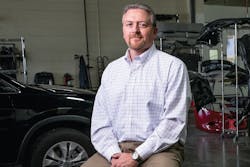Tony Adams remembers writing down all three items in a notebook, and just staring at them.
As the operator and co-owner of Weaver’s Auto Center in Shawnee, Kansas, Adams knew something was amiss in his business—or, really, he could feel it in the built-up frustration he had in the shop’s performance.
This was 2008, and while Adams sat in a leadership seminar, his shop was two years post expansion, having moved into a sparkling new facility in 2006. It generated just $2 million in total sales out of 30 employees and 21,000 square feet, and a third of that business came from the shop’s mechanical segment.
He didn’t know how to improve, and he couldn’t get through to his team; thus the leadership training.
Now, those three items he had in his notebook:
1. Know who you are as a business.
2. Manage staff based on expectations.
3.??Have a system and culture that allow for direct communication amongst the team and management.
Adams was supposed to check off all he felt his company achieved.
Cue the blank stare.
“Probably the hardest pill for me to swallow was that I was the biggest problem in my organization,” he says. “I tried to rule with an iron fist, through fear. That doesn’t work. It can’t work. I knew I had to focus beyond the day-to-day and really improve who we were as a company.”
Adams decided that he needed to create a business where each team member strived for the same goal, where everyone had a stake. To do that, he’d lean on an unconventional form of organizational structure, and one simple rule.
The Backstory
Adams became a partner at Weaver’s in 1996, when he was just 22.
He had worked in the shop when he was in high school, and was promoted to parts manager upon graduation. The next year, he took over production. He became general manager the year after that, and then was offered a stake in the company.
“I guess it progressed quickly,” Adams, 40, says with a laugh.
A young manager in charge of a flourishing shop, Adams says he focused heavily on operations, working to perfect the workflow in the back of the shop. Roughly 16,000 feet are dedicated to collision work, with a few thousand designated to mechanical.
Over his first decade in charge, Adams says he learned to become a true manager. It took him two more years to realize he had no idea how to be a true leader.
The Problem
It was simple: The business wasn’t showing any growth.
And Adams was frustrated. He felt he motivated his team—or, at least, pushed them hard. Systems, processes and procedures were in place for everything in the shop. It should’ve produced efficient workflow. It should’ve produced some sort of results.
His team of 30 (roughly half of which were dedicated solely to collision) simply didn’t seem to share Adams’ passion to push the business forward. They did what they were told; nothing more.
Then came the leadership seminar, put on by Kevin Wolfe of LeadersWay.
And then came the epiphany.
Adams had been focused solely on the results of the business: sales, margins, profits, cycle time, etc.
“The focus is always profit, profit, profit,” he says. “But that’s just a result. It doesn’t tell you if you’re doing things right, it doesn’t tell you how well you’re running your business. It’s just a result.
“We didn’t have a clearly defined vision of who we were as a company. We didn’t have expectations. We didn’t have any open communication. We needed to figure out who we were as a company, and I had to figure out how to lead us in that direction.”
The Solution
Adams had always been an avid reader, and he began researching businesses in other industries that were renowned for their company culture. One that stuck out the most was Southwest Airlines.
“You look at them, and they have these enormous waiting lists of applicants, people who want to work there,” he says. “Is it because they have the best planes, or the cheapest flights, or they’re on time? No, every airline can do that, and maybe some are better. What they’re able to do is make connections with people and build relationships with customers.”
That was what Adams envisioned for his shop.
“We can’t sit there and spout off about our warranty or how well we fix cars or that we’ll get it back to them on time,” he says. “That’s what customers already expect. That’s a minimum; that’s what it takes just to be in the game today.
“Our goal became that we wanted to really engage people, and provide service and that connection that no one else could.”
And Adams’ plan started with one simple rule.
He determined that the only way to reach a point where everyone is on a unified team working toward the same goal (that goal being optimum service to each customer) was to cut out all the bickering, gossiping, bad blood or any other distractions his team had. Happier, more satisfied employees give better service; it’s that simple, he says.
So, here’s the rule: If anyone has an issue in the shop, whether it’s with a colleague, manager, vehicle, etc., they have 24 hours to bring it up and deal with it, or they’re never allowed to talk about it again.
“The idea was to create a self-policing sort of environment,” he says. “If they know they have to deal with an issue that day, they aren’t going to have it linger.”
They also aren’t going to need a micro-managing owner looking over their shoulders.
Adams began to shift his leadership style, too. He became less focused on day-to-day processes, and more determined to set expectations for his staff and help them meet them. Each member of his team already had job descriptions; those in the shop already knew they had to follow OEM repair guidelines or match paint correctly. They didn’t need Adams reminding them, he says.
FINDING THE RIGHT PEOPLE
Having talented people with the right goals and attitude is the most important aspect of going through a transition like his shop did, Adams says.
The majority of his current employees came to him on referral, either through vendors, colleagues or his staff. Recruiting is paramount, and Adams does it in a number of ways:
Every employee is either paid based on salary or hourly wages at a high-performing rate. Adams doesn’t want any independent contractors in his shops, and he wants people who are attracted to that environment. Adams also provides continuing education to his team through I-CAR and LeadersWay. And the shop’s atmosphere on tours plays an enormous role.
When he conducts interviews, Adams goes through an extensive process, usually three or four interviews, each focusing on the person’s attitude and passion for what they do.
“You ask them things like what they were most excited about doing at their previous job or what their greatest accomplishments were there, and you look for that passion to come out,” he says.
“Nothing’s foolproof, but you’re looking for people that want to grow and people that want to be in an environment where things are done right.”
“You instead focus with them on the expectations, their individual goals for efficiency or productivity or cycle time,” he says. “You let them know that those are expectations that have to be met—and doing things ethically. The only thing you care about is that they meet those expectations.
“I wanted them to feel more autonomous in the way they worked, let them have more independence and creativity in their work.”
The Aftermath
Adams knew heading into the transition that the most difficult aspect would be making sure he had the right people on board to go along with these wholesale changes.
He didn’t. Many of his team members left or were let go over the course of the following five years. Each time one did, though, they were replaced with someone eager for the shop’s new environment. (See “Finding the Right People” on the opposite page for how Adams hires for attitude.)
By 2014, only two of Adams’ original employees were left. But, the now 28-person team churned out $4.5 million in sales in 2013, $3.2 million of which was collision.
And, while Adams feels he and his team always have room for improvement, the difference in the shop’s atmosphere is night and day. By giving his team more freedom, Weaver’s Auto Center has created a flat hierarchy of leadership. The team polices itself, and more than Adams ever expected, is focused on pushing the business forward.
Now that he simply gives his team an expectation—“We need to achieve X,” he says—and they figure out how they will do it.
“We’re a [PPG] Green Belt shop, and we’re always giving tours of our shop floor to other shops,” Adams says. “But that shop floor—the way it’s laid out, the way it operates—is 100 percent the team in there. They did it all. They organized it. They came up with the concepts we have in place. That’s their shop.”
For instance, his team, tired of clunky toolboxes and underutilized equipment, made the decision to start sharing tools with each other. They consolidated toolboxes (putting their names on their own products) and put everything on mobile carts. The staff also started a Thursday activity, where they’ll pool cash together for lunch or go to a happy hour following work.
And, although it’s inevitable for issues to creep up in any business, Adams says they are handled more quickly—and almost always before he hears about them.
The Takeaway
Adams, who is now a certified business coach with LeadersWay, is glad that he can quickly check off all three items on that initial list today.
His business is running itself, and he’s thrilled with the direction it’s heading.
“You have to know who you are as a company to be able to grow and succeed,” he says. “What’s going to differentiate you? What’s going to allow you to connect with customers? What’s going to help you become successful?”




